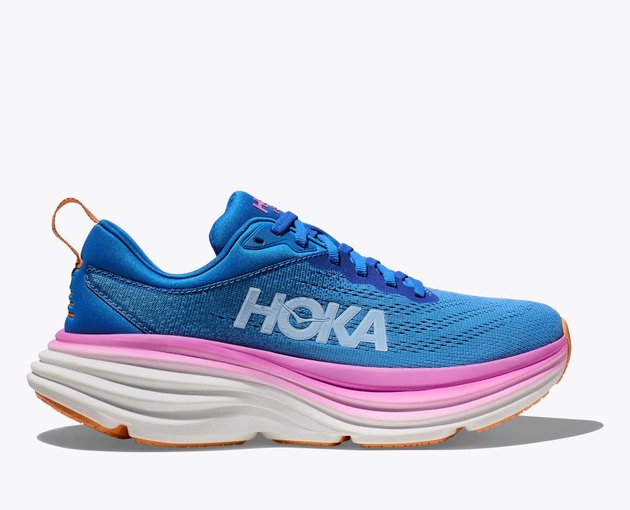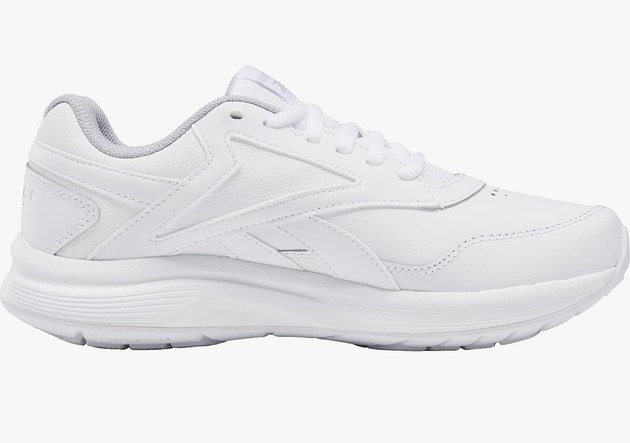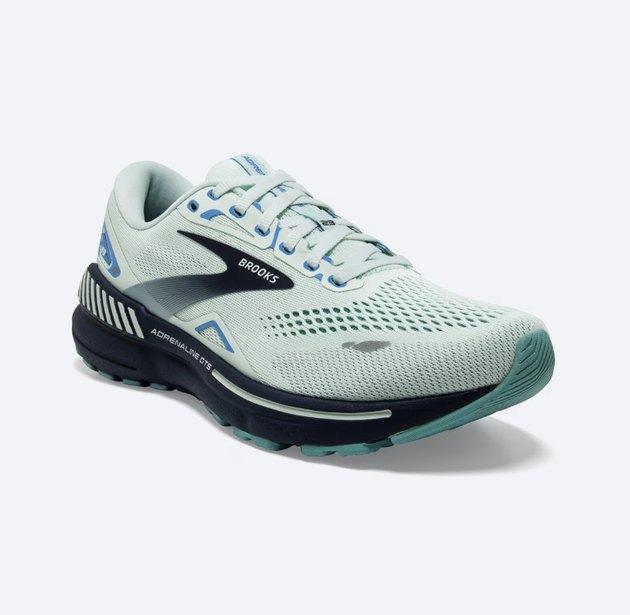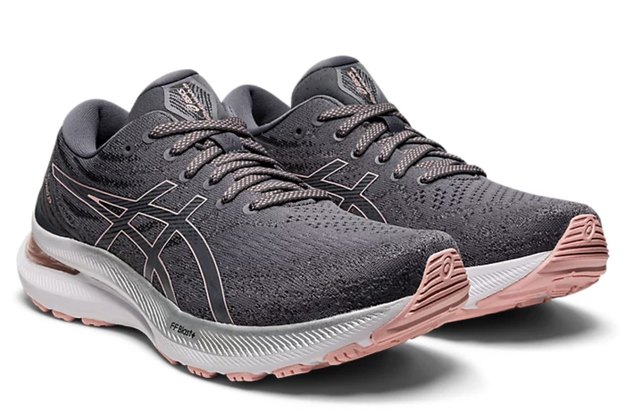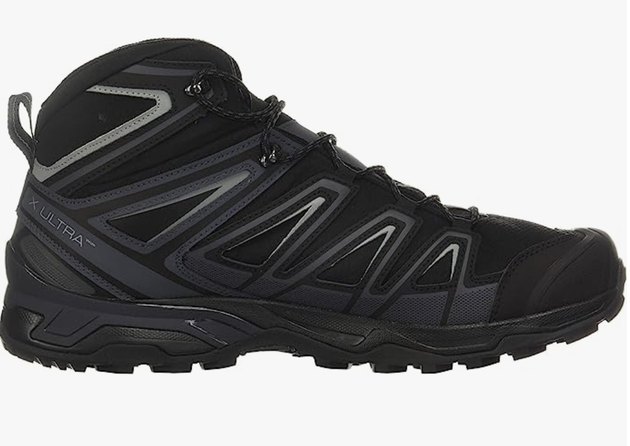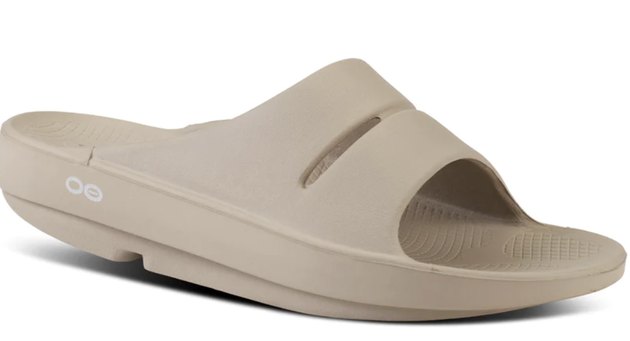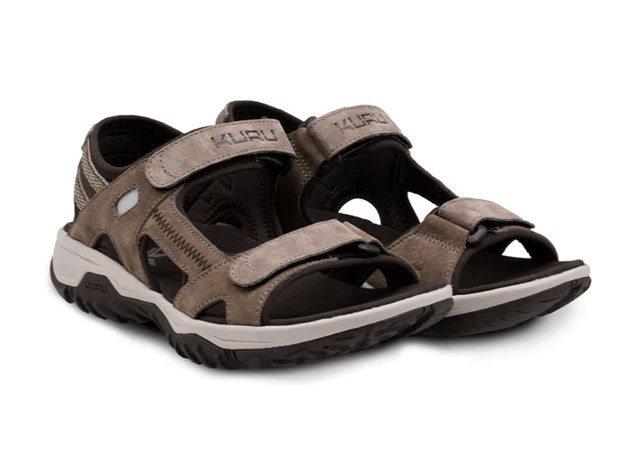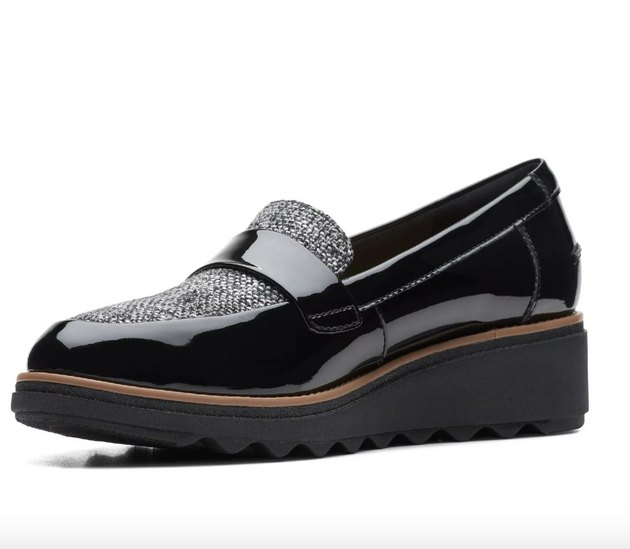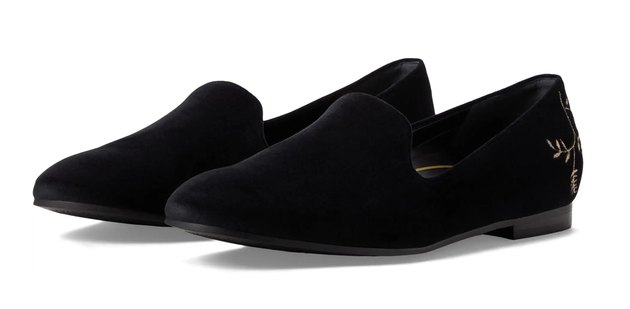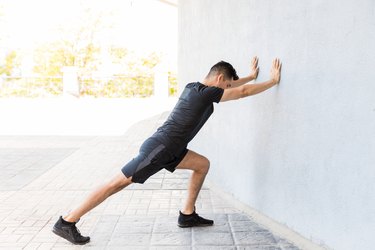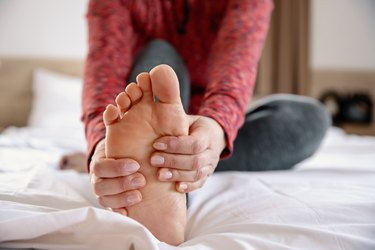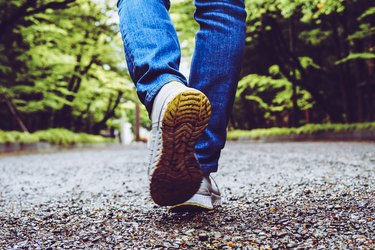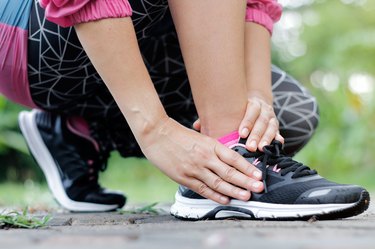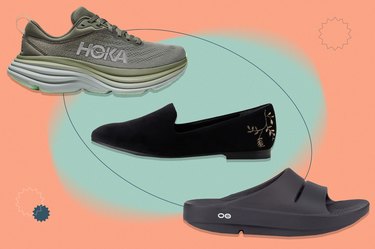
Anyone who has ever dealt with plantar fasciitis knows how uncomfortable and disruptive it can be — and how good it feels when you finally find relief. When it comes to the latter, a good pair of shoes can make all the difference.
"Plantar fasciitis occurs when the tissue across the sole of your foot (from your heel bone up to your toes) becomes inflamed, which then causes pain in your heel and arch," says Jeffrey Cohen, DPM, chief of podiatry at Englewood Health.
Video of the Day
Video of the Day
You can relieve the pain of plantar fasciitis by taking anti-inflammatory medication like ibuprofen, regularly stretching the soles and arches of your feet and wearing high-quality, comfortable shoes, Dr. Cohen says.
Read on to find the right pair for your needs.
The Best Shoes for Plantar Fasciitis
- Best Overall: Hoka Bondi 8 (Hoka, $165)
- Best on a Budget: Reebok Walk Ultra 7 DMX MAX (Amazon, $64.99)
- Best for Walking: Brooks Adrenaline GTS 23 (Brooks Running, $140)
- Best for Running: Asics GEL Kayano 29 (Asics, $109.95)
- Best for All-Day Standing: Orthofeet Coral Stretch Knit Sneakers (Amazon, $129.95)
- Best for Hiking: Salomon X Ultra 3 Mid GTX (Amazon, $165-$195.59)
- Best Sandals: OOFOS OOahh Slide Sandal (Oofos, $59.95)
- Best Sport Sandals: Kuru Tread Sandals (Kuru, $145)
- Best Dress Shoes: Clarks Sharon Gracie Comfort Loafers (Walmart, $66.99)
- Best Flats: Vionic Willa Flats (Zappos, $129.95)
How We Chose
We asked Dr. Cohen about his top picks and what to look for in shoes for plantar fasciitis. The shoes below were chosen based on the following criteria:
- Level of comfort and support
- Quality
- Cost
- Availability
Find more information on how we choose and cover products here.
A Quick Language Note
We try to avoid using gendered language to be more inclusive, but manufacturers typically market shoes to men or women, which is why we've included this language below.
Keep in mind that the main difference between most men's and women's shoes lies in the shoe width and size. In some cases, men's shoes are built to support greater weights. So people with bigger bodies may want to opt for men's versions, whereas people with smaller bodies may prefer women's versions. We encourage everyone to choose the shoe that works best for them, regardless of marketing lingo.
1. HOKA Bondi 8
Pros
- Cushion
- Plenty of support
- Many width options
- Lightweight
Cons
- Pricey compared to some other options
From its durable, thick sole to its memory foam collar, the HOKA Bondi 8 sneaker puts comfort first — the brand even touts it as its most cushioned running shoe.
In addition to its overall cushioning, this sneaker provides structure and support where your feet need it most: throughout the middle of your foot, around your ankle and achilles tendon.
The Bondi 8 is available in regular (D) and wide (EE) fits. Plus, it comes with the American Podiatric Medical Association (APMA)'s seal of acceptance, meaning it's been verified to help support your feet's overall health.
2. Reebok Walk Ultra 7 DMX MAX
Pros
- Budget-friendly
- Comfortable and lightweight
- Made with foam
Cons
- Only two color options (black and white)
- Some reviewers say they run narrow
The Reebok Walk Ultra 7 DMX MAX also prioritizes comfort at a more affordable price point. Its sturdy — yet lightweight — construction encourages airflow within the shoe and it was designed with those who spend all day on their feet in mind.
Those with plantar fasciitis will appreciate the way this sneaker's foam reduces pressure points around the heel and ball of the foot.
Tip
Another way to find affordable sneakers is to browse models from previous years and seasons, Dr. Cohen says. These will likely be sold at a discount compared to the newest models.
3. Brooks Adrenaline GTS 23
Pros
- Lightweight
- Made from recyclable materials
- Arch and heel support
Cons
- Some reviewers say they take some time to break in
Brooks often gets high marks for its running shoes, but that doesn't mean you should overlook its walking shoe selection.
The Adrenaline GTS 23, in particular, is well-suited to people with plantar fasciitis thanks to its ultra-cushioned heel and midsole.
Beyond that, its GuideRails and mesh support systems provide the level of structure needed for longer wear.
4. Asics GEL Kayano 29
Pros
- Shock-absorbing
- Stabilizes your midsole to prevent rolling
- Comfortable
Cons
- Some reviewers say the toe box is narrower than previous models
Runners with plantar fasciitis should make sure their sneaker of choice is designed to absorb shock and resist compression.
The GEL Kayano 29 from Asics does both, softening the impact of landing while encouraging a smooth, bouncy push-off. It also stabilizes the midsole and arch to prevent feet from rolling inward. This balance of structure and comfort are key to reducing the unpleasant symptoms of plantar fasciitis.
5. Orthofeet Coral Stretch Knit Sneakers
Pros
- Comes with an orthotic insole and arch booster
- Knit material forms to the contour of your feet
- Durable
- Lightweight
Cons
- Some reviewers say they run small, which may cause blisters on your heels
If you are a nurse, work in the food service industry or any other job where you're on your feet 24/7, these shoes by Orthofeet could help you out. They are designed with orthotic comfort in mind — helping soothe a number of foot conditions, including plantar fasciitis. The knit material of the shoe contours to the shape of your foot, plus they are lightweight. You won't even feel them throughout the day!
Just make sure to wear socks with them — they can take a bit to break in and you'll need the extra cushion.
6. Salomon X Ultra 3 Mid GTX Hiking Boots
Pros
- Durable
- Elevated heels for comfort
- Provide ankle support
Cons
- Some reviewers say the sole feels too thin
Featuring a contoured insole and heel cup, OrthoLite sock liners and an overall stabilizing shape and design, Salomon's X Ultra 3 Mid GTX hiking boots are as durable as they are wearable. They support, cushion and elevate the heel of the foot in order to ensure comfort throughout long hikes, which should help alleviate the pain caused by plantar fasciitis.
The mid-rise profile on these boots for plantar fasciitis provides added support without confining the ankle or causing discomfort. Generally speaking, this is an important feature to look for in any hiking shoe, as it will help to keep your feet steady as you navigate rocky terrain, Dr. Cohen says.
7. OOFOS OOahh Slide Sandal
Pros
- Absorb impact
- Relieves stress on joints
- Arch support
- Made with foam
Cons
- Some reviewers say their feet get sweaty easily
For the record, sandals are not the best choice when it comes to plantar fasciitis-friendly shoes because most are thin or lack structure, Dr. Cohen says.
That said, if you want an open-toed style for the summer months, a recovery sandal, like the OOahh Slide from OOFOS, is your best option.
Unlike most sandals, these slides are designed to absorb impact, reduce stress on joints and support the arches of your feet. This is thanks in large part to the foam material they're made of, which not only provides firm comfort but also helps prevent foot odor.
8. Kuru Tread Sandals
Pros
- Waterproof
- Made with lightweight foam to support and protect your heels
- Breathable
Cons
- Don't come in half sizes
If you're looking for a sport sandal that allows your toes to breathe while supporting your heels and arches, this pair from Kuru Footwear is a great pick. They are made with patented lightweight foam that contours to the shape of your foot (perfect for people dealing with plantar fasciits), and offers enough stability so that you don't roll your ankles while hiking.
Plus, they are waterproof and have thick straps with hooks and loops: perfect for day at the beach or a light trail walk.
9. Clarks Sharon Gracie Comfort Loafers
Pros
- Arch support
- Raised heel
- Made with a foam comfort heel
- Stylish
Cons
- Don't come in different colors
You don't have to sacrifice style in the name of comfort and support. With these penny loafers from Clarks, you could have it all. The shoes come with a raised heel and foam inside the shoe for optimum heel and arch protection. The men's version (which comes in tan and faux brown leather) offers the same perks.
Plus, they come in wide widths and a variety of sizes. But don't wait to buy; this style is often out of stock.
10. Vionic Willa Flats
Pros
- Podiatrist-designed footbed
- Arch and heel support
- Made with breathable material
Cons
- May take some time to break in, according to reviewers
- Can run big, according to some reviewers
- Pricey
Sometimes, you need an option besides sandals and sneakers, even if you're dealing with plantar fasciitis. That's where these flats from Vionic come in. They're made with a podiatrist-designed footbed (the brand's Orthaheel technology) to offer support for a number of foot conditions, including heel pain, arch pain and you guessed it, plantar fasciitis.
These flats are easy to throw on, are made with breathable suede material and come in a few different color options.
What to Look for in Shoes for Plantar Fasciitis
1. Comfort
When it comes to picking shoes, comfort should always be number one priority, especially when dealing with plantar fasciitis pain.
Look for shoes that have thick inner and outer soles, or ones that feature foam in their designs. You may need to try on a few pairs before you find the right one for you.
2. Support
Dr. Cohen says it's also important to prioritize support when shopping for shoes to help with plantar fasciitis. An insole that your foot sinks into over time will not relieve your pain.
Instead, look for one that's comfortable and capable of reducing the impact on your heels. More often than not, this means choosing a running shoe. "This type of shoe offers the best support, flexibility and shock absorption," Dr. Cohen explains.
3. Lifted Heels
The American Academy of Orthopaedic Surgeons recommends choosing a pair of shoes that not only feature cushioned heel cups but actually elevate the heels. This slight lift will provide even more support to the part of your foot that needs the most relief.
If you find a shoe that checks all the boxes except for this one, you can add a heel-only insert (like this one from Dr. Scholl's) and get a similar effect.
4. Durable
Wearing shoes that are worn out in the heel and sole can actually cause plantar fasciitis to flare up, according to the AMPA.
So, you may want to consider the potential lifespan of a new pair of shoes before you commit to them. Choosing a durable shoe now could help you avoid heel pain in the future.
What to Avoid in Shoes for Plantar Fasciitis
1. Flat Insoles
Again, support is key, Dr. Cohen says. While some people prefer a flat heel versus a lifted one, the former are going to lack support in the heel and arch.
In other words, flat insoles aren't going to reduce your pain from plantar fasciitis. In fact, they may increase the stress placed on your feet and make your symptoms worse.
2. Thin Soles
Most boat shoes, sandals, flats, and dress shoes will do more harm than good if you have plantar fasciitis, per the APMA. Not only do these types of shoes tend to have flat insoles as described above, but they also have thinner, harder soles that offer little support or shock absorption, let alone long-term comfort.
If you must wear these kinds of shoes, try not to wear them for extended periods of time or while exercising.
When to See a Doctor
Although a supportive, cushioned pair of shoes will help reduce the discomfort that comes with plantar fasciitis, it doesn't guarantee to heal plantar fasciitis.
If your pain persists after a few weeks, gets worse or affects you even when you aren't standing or walking, make an appointment with a podiatrist. They may recommend physical therapy, custom orthotics or steroid injections in addition to wearing comfy shoes, Dr. Cohen says.
Is this an emergency? If you are experiencing serious medical symptoms, please see the National Library of Medicine’s list of signs you need emergency medical attention or call 911.
